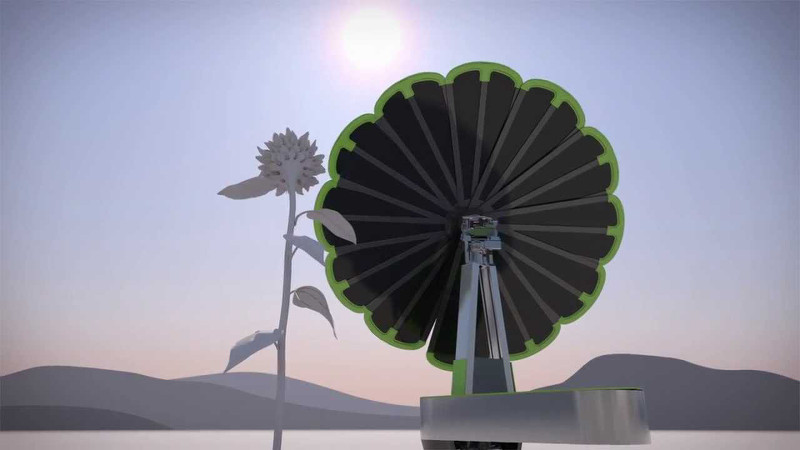The solar PV industry may be the most renowned element of the renewable energy revolution these days, but in many cases of corporate adoption of solar power, there has been little public recognition. Vast rooftop arrays of solar panels are virtually unseen by the public eye despite millions of dollars spent and legions of kilowatt hours now flowing through host buildings.
A few years ago, solar advertising got off to a poor start, combining corporate banners and large-scale logos with solar arrays – the trend never really got off the ground, perhaps in part because green is not gauche.
Today, a new breed of highly visible solar installations is serving to call attention to not only the host’s commitment to solar, but also to communicate – and give away – some of the practical benefits that solar energy brings: free charging stations for electronic devices, power for free Wi-Fi, and free lighting for public security.
These more eye-catching solar PV installations are being produced by a handful of companies located around the world, incorporating designs ranging from solar benches to solar trees, and a few more interesting sculptural shapes in between.
“We like to consider our solar tree as functional art. The inventor’s vision was of enhancing solar awareness and the quality of the community, in the form of a giving tree. It is more important for us to share the solar tree’s benefits with the community than to make the actual sale,” says Brad Langerak, the Vice President of the U.S. office of E-Tree, in Aurora, Colorado.
Solar benches
Solar benches seem most immediately practical within this group, offering a place to rest while recharging, while using one’s device, and possibly while learning about the host solar program, including the bench itself.One solar bench developer is Strawberry Energy, based in Belgrade, Serbia. Founded by designer Miloš Milisavljević, Strawberry recently won a commission for an installation at London’s Canary Wharf. Apart from standard recharging, free Wi-Fi and lighting, the Smart Benches track air quality and noise levels in the surrounding area and include an emergency call button that hails the Canary Wharf Help Estate Centre.
Strawberry Energy won the Verge Accelerate 2014 in San Francisco, was a finalist in the World Technology Award 2013, and the Strawberry Tree was named one of the ‘Top 10 Urban Innovations That Work’ at the New Cities Summit in Dallas.In 2014, Strawberry Tree was also the first startup from Serbia to receive $100,000 in startup money from Bulgarian Accelerator Venture Fund Eleven. Out of 276 applications from 26 countries, 11 companies are chosen for the investment, and only five received this amount of funding.
The company sells trees and benches, and has also designed a personal Strawberry Mini for individual use, as well as a Strawberry Mini Rural for roving recharge services in off-grid municipalities. The bench is 2.6 meters high and 2.4 wide, and the entire structure can be lifted and moved to different venues. It generates 90 watts, and offers sensors for CO2level, noise, humidity, pressure, and temperature data, to be sent to the cloud for analysis.Another developer of solar benches is E-Tree, developed by Sologic, in Benjamina, Israel, which also produces solar trees. A tricked-out version of the E-Tree plus bench includes recharging, Wi-Fi, lighting, water for both humans and dogs, and an interactive LCD screen. The screen can provide a link to the host solar program, and may communicate other public messages, like weather forecasts, news, and perhaps even a small advertising banner across the bottom of the screen.
Solar trees
The E-Tree is no slight installation. The largest version stands at 4.5 meters and weighs in at 1,250 kg. The tree cranks out 1,400 watts or about 7 kWh per day, in low voltage DC. All materials for the tree presently come from Israel, but the company is negotiating with SunPower to produce the glass-on-glass silicon panels that a third U.S. company would encapsulate. Each panel is connected to the steel frame by means of four holes through the panel.“The most difficult step of developing the tree was designing the connections,” says Langerak.
Depending on the size and accessories, the E-Tree cost can run from $10,000 to $100,000. The company has thus far sold small clusters of E-Trees to various academic, corporate, municipal and utility customers, but recently has begun negotiating forest-sized rollouts with several customers that have regional or national footprints.Another solar tree manufacturer is Spotlight Solar, based in Chapel Hill, North Carolina. “Our product is a case of ‘art meets clean energy machine.’ We like to use the term beautiful machine to describe our tree, because it is functional but looks fantastic; we are careful not to make it look like an art project,” says Craig Merrigan, the Founder and CEO of the company.
“This past year, we have gained a lot of traction within the education sector; our latest installation will kick off at San Diego State University soon,” he says. Spotlight has also installed at convention centers, rail stations, sports arenas, and utility campuses, apart from corporate sites. “We expect to gain ground with big box stores in the near future,” he adds.
Spotlight uses Lumos LSX glass-on-glass polycrystalline solar panels, and the trees are manufactured in either Ohio or New York facilities. “The trees can incorporate QR codes that will take mobile phone/tablet users to a web site, but they also will integrate educational curriculum over time, perhaps via Near Field Communication (NFC),” Merrigan says.
The cost of the Spotlight tree runs from $30,000 to $50,000, with output running from 1.5 kW to 4.5 kW. The trees stand over 20 feet high, sport square arrays of panels on steel branches in a variety of configurations from angular to curved, and come in 200 different colors. The steel used in the framing is up to 80% recycled, and the array is wind tested up to 150 mph.
“We don’t state the cost in terms of watts produced,” points out Merrigan. “The way to consider the cost is as a communications campaign: What other ways might you conduct one – building attached awning, leading roof tours, or doing a PR campaign – and how much do they cost?” he asks.
Emulating nature
A more naturally shaped solar station is being produced by smartflower, based in Vienna. The 670 kg smartflower all-in-one solar system is pre-assembled and resists panel overheating thanks to its 2 mm glass-EVA encapsulation. The flower unfolds its panels around a dual-axis tracker, yielding 2.3 kW peak. One version of the tracker folds itself down into a ground case, discouraging overnight tampering.
Already sold into 20 countries, the smartflower carries a U.S. sale price of around $10,000, where it “may become as ‘eco-iconic’ as the Tesla parked in owners’ driveways,” suggests Alexander Swatek, the CEO and Founder of the startup. With a five year warranty, he expects sales in the U.S. to be financed via operational leases with buyout options, like cars.
For those customers interested in a storage option, smartflower offers on-grid and off-grid solutions with either a 2.3 kW battery bank or a 4.6 kW battery bank. Batteries are supplied by Victron Energy, of Almere Haven in the Netherlands. “We haven’t finalized the U.S. pricing for the storage option, but it might roughly add $5,000 to the price of the system,” says CEO and Founder Swatek. The company will launch smartflower this month at InterSolar North America in San Francisco.
This content is protected by copyright and may not be reused. If you want to cooperate with us and would like to reuse some of our content, please contact: editors@pv-magazine.com.



I agree about the importance of creating art with solar. I have seen the video of this sunflower opening, tracking and closing back down. I thought it would be great to have a link to it here as well.
I designed a static Solar Sunflower 25-feet high and 18-feet in diameter in Springfield Illinois that is view able from Google Maps as “Rotary Sundial”. It is actually a solar calendar with sunrise and sunset, solstice and equinox viewing benches and a human interactive sundial.